Webinar text. Page 2
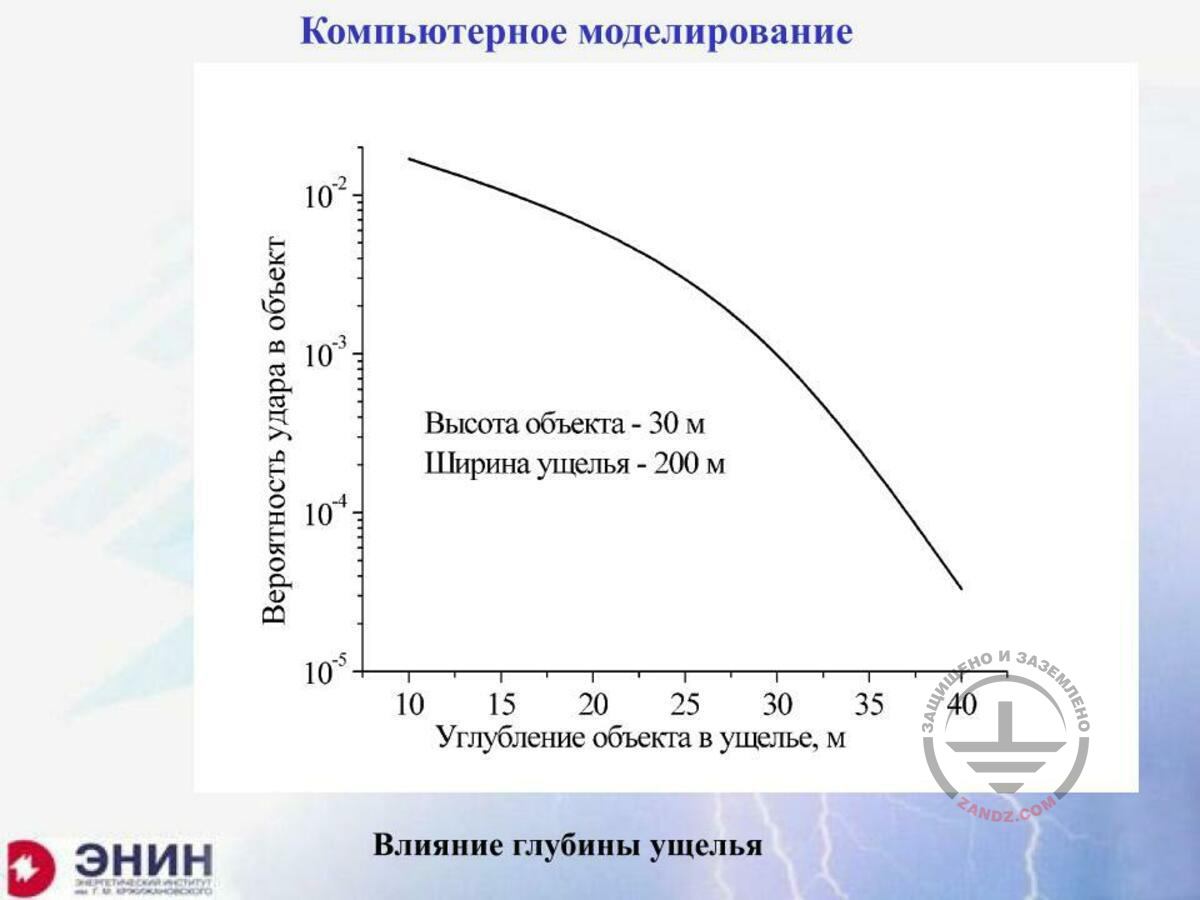
Gorge depth impact
Компьютерное моделирование
Вероятность удара в объект
Углубление объекта в ущелье, м
Высота объекта – 30 м
Ширина ущелья – 200 м
Computer modelling
Probability of the strike into the facility
Facility depth in the gorge, m
Facility height — 30 m
Gorge width — 200 m
Here, I have taken the gorge having the width of 200 meters, and the facility having the height of 300 meters. And now, depending on the depth, even at the depth of 30 meters, the lightning breakthrough probability in the gorge is at a level of 0.999. This is a good reliability for a good lightning protection.
– Eduard Meerovich, excuse me, I have a question. Vladimir wishes to clarify the gorge depth.
– I show you the gorge depth; it is shown here, in the diagram. I make calculations for a 200-meter wide gorge, the facility is in the middle of this gorge and has the height of 30 meters. And if the gorge is higher than the facility for only 30 meters, the probability of the lightning strike to the facility drops to a level of 10-3, i.e. only one lightning out of thousand will strike the gorge. Do we need an additional lightning arrester here? Certainly, not. Moreover, if you have a wire lightning arrester, and the facility is a power line, such wire lightning arresters are harmful because it is a mountainous area. There are strong winds and glaze ice in the area.
And the ice breaks wires.
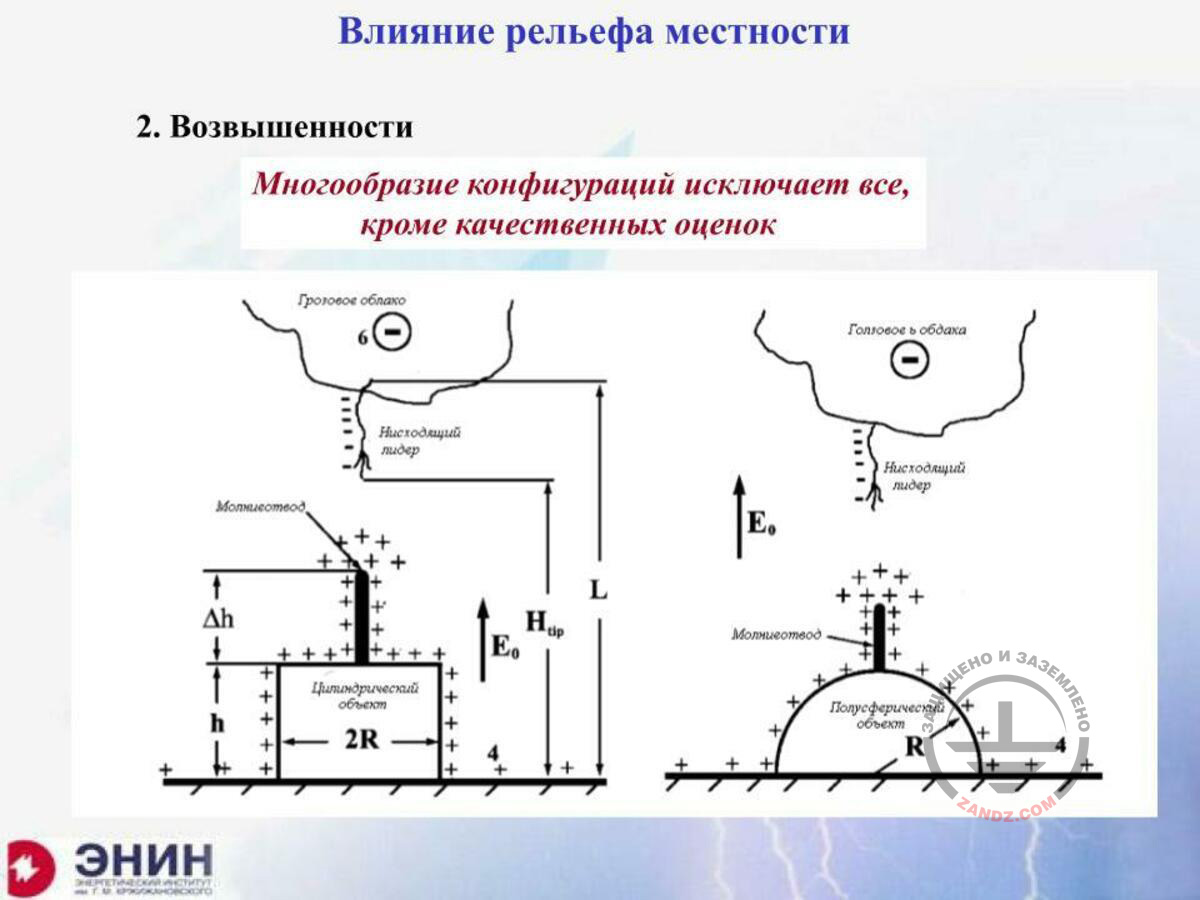
Landscape impact. Uplands
Влияние рельефа местности
2. Возвышенности
Многообразие конфигурации исключает все, кроме качественных оценок
Грозовое облако
Нисходящий лидер
Молниеотвод
Цилиндрический объект
Полусферический объект
Landscape impact
2. Uplands
Numerous configurations exclude anything except qualitative estimates
Thunderstorm
Downward leader
Lightning arrester
Cylindrical facility
Hemispheric facility
Now, let's go to the other side. To the side we are going now, i.e. uplands. The gorge is very good, but there are also hills, mountains, raised locations where the facilities may be placed. What can we do in this case? What can we calculate? Surely, we can make calculations for any mountainous landscape, although this is an extremely complicated and ungrateful task. Therefore, we have generated two models for such system. The first model is a cylindrical facility whereon the lightning arrester is installed. And the second model is a hemispheric facility whereon the lightning arrester is installed. Both tasks may be solved by using the computer in a pretty good approximation, and the results allow concluding on what happens in this case.
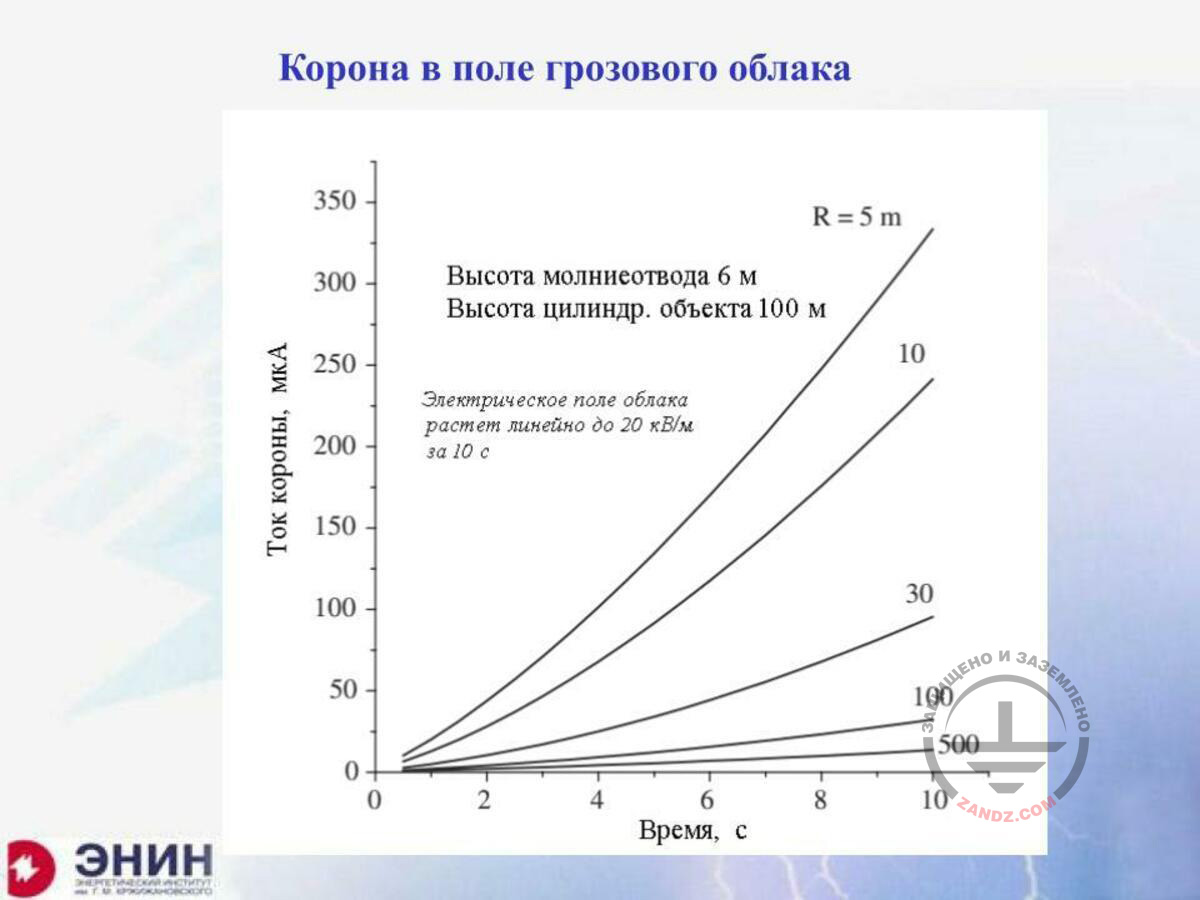
Crown in the thundercloud field. Height 6 m
Корона в поле грозового облака
Высота молниеотвода 6 м
Высота цилиндр. объекта 100 м
Электрическое поле облака растет линейно до 20 кВ/м за 10 с
Время, с
Ток короны, мкА
Crown in the thundercloud field
Lightning arrester height 6 m
Cylindrical facility height 100 m
The electrical field of a thunderstorm grows in a linear fashion up to 20 kV/m for 10s
Time, s
Crown current, mcA
Again, the impact indicator will be an opposed discharge. I begin analyzing the opposed discharge from the lightning arrester of 6 meters high (in this case), which is placed on a cylindrical facility of about one thousand meters high. And I will change the radius of this cylinder. Look at what happens. There is a radius of this cylinder on the curves showing the lightning current on each curve. I have started with the cylinder radius of 5 meters and finished with the cylinder radius of 500 meters. So, as far as the radius of the cylinder increases, the crown current reduces. Here, the cylinder is actually an extension of the lightning arrester. And here, this high landscape turns into the plane because, for the lightning arrester, the distance of 500 meters in all directions is a flat top. And it occurs that the development of the opposed discharge depends not only on the height of the upland but also on the radius. If you have a flat top, then there is almost no impact. The lightning arrester considers its position as the position on the ground surface.
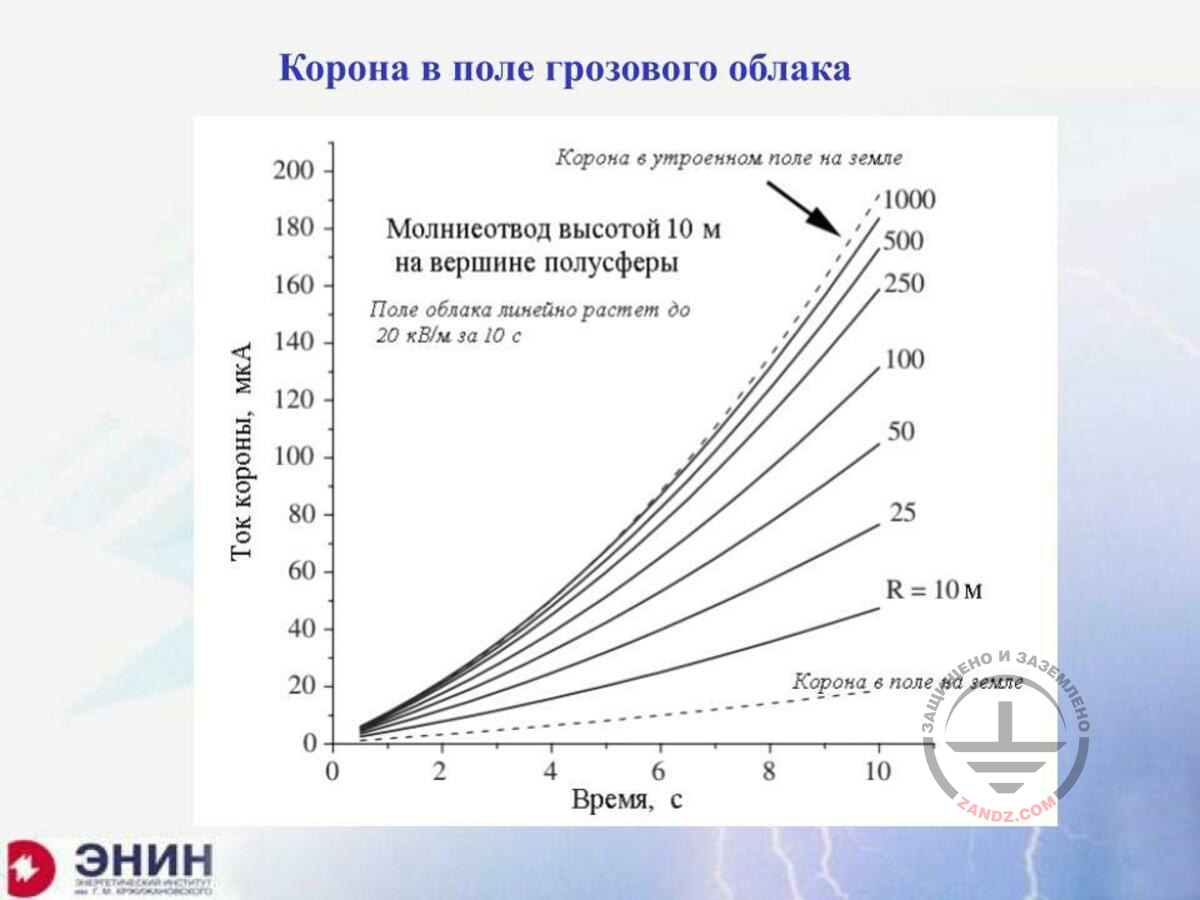
Crown in the thundercloud field. Height 10 m
Корона в поле грозового облака
Корона в утроенном поле на земле
Молниеотвод высотой 10 на вершине полусферы
Поле облака линейно растет до 20 кВ/м за 10 с
Ток короны, мкА
Время, с
Корона в поле на земле
R = 10 м
Crown in the thundercloud field
Crown in a 3x field on the ground
The lightning arrester with the height of 10 m at the hemisphere top
The thundercloud field grows in a linear fashion up to 20 kV/m for 10 s
Crown current, mcA
Time, s
Crown in the field on the ground
R = 10 m
A similar, but a little bit different situation is true for a hemisphere. I am plotting these curves again. I take almost the same lightning arrester of 10 meters high. I install it on the hemisphere top, and I begin changing the radius of this hemisphere from about 10 meters to 1,000 meters. The 10-meter hemisphere is a rather sharply extending formation, while the 1,000-meter hemisphere is almost a flat ground surface. And the following thing happens, again: depending on my radius, the crown current changes. It means that not only height is of importance but also the profile that describes the elevating facility in mountains. And it appears that no complete single solutions may be obtained here. If you want to consider your particular facility located in the mountains and if it is located on an upland, there is only one way out: you have to describe and solve a task of strengthening the electrical field of the thunderstorm on the upland. I think that due to the fact that this task is generally solved in a pretty complicated manner, but we have to solve it rather rarely; not a single regulatory document, neither Russian nor the one of the International Electrotechnical Commission, contains anything like that. If such task arises and we have an important facility we need to install on a mountain top. Because we have to. Can we do that? Yes, we can. We can certainly calculate the electrical field, the opposed discharge, and the collection radii.
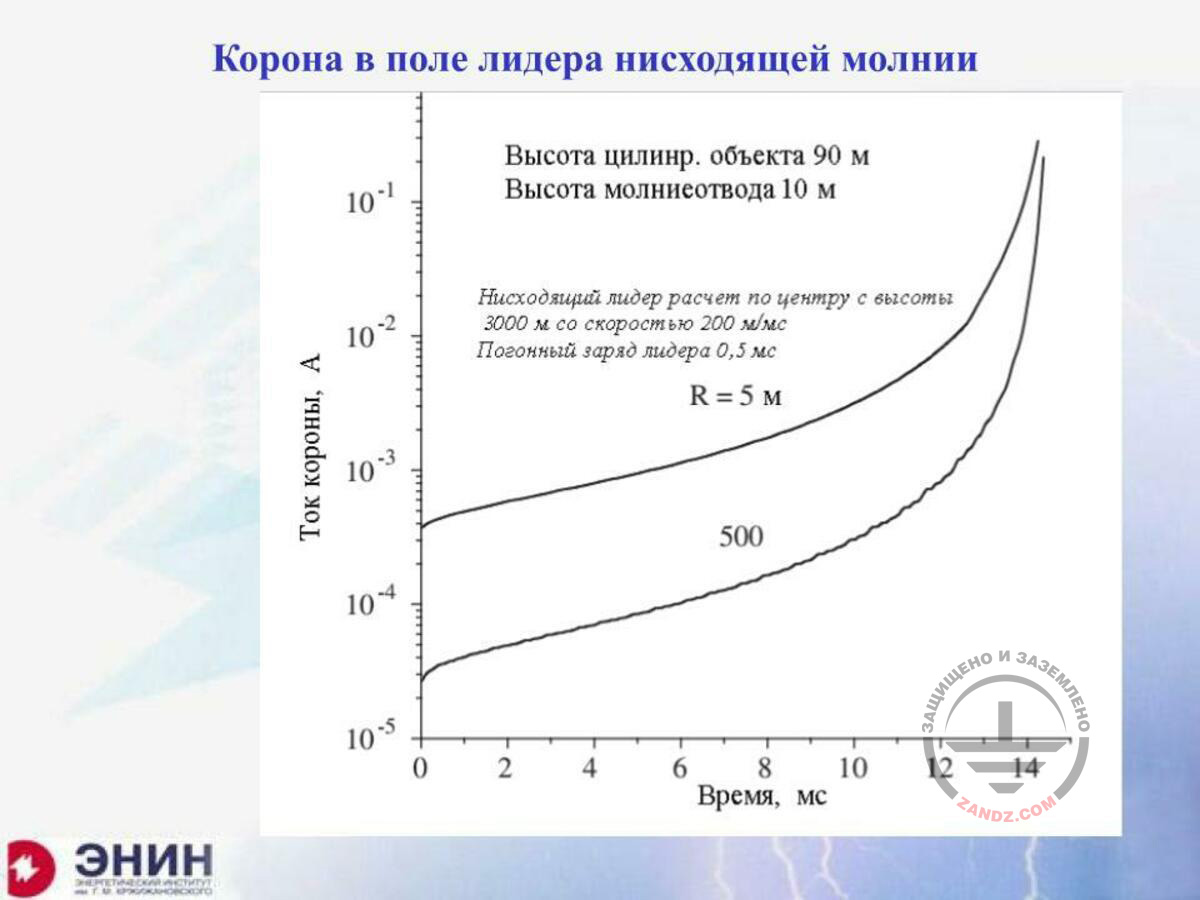
Crown in the downward lightning leader field
Корона в поле лидера нисходящей молнии
Высота цилинр. объекта 90 м
Высота молниеотвода 10 м
Нисходящий лидер расчет по центру с высоты / 3000 м со скоростъю 200 м/мс
Погонный заряд лидера 0,5 мс
Ток короны, А
Время, мс
R = 5 м
Crown in the downward lightning leader field
Height of the cylindrical facility 90 m
Height of the lightning arrester 10 m
Downward leader: calculation in the center from the height of 3,000 m with the speed of 200 m/ms
Linear leader charge 0.5 ms
Crown current, A
Time, ms
R = 5 m
But the impact of height in such facilities has to be considered because for the facility placed on an upland and located on a flat ground surface, the difference between the number of strikes exists, and this difference will not have any significance.
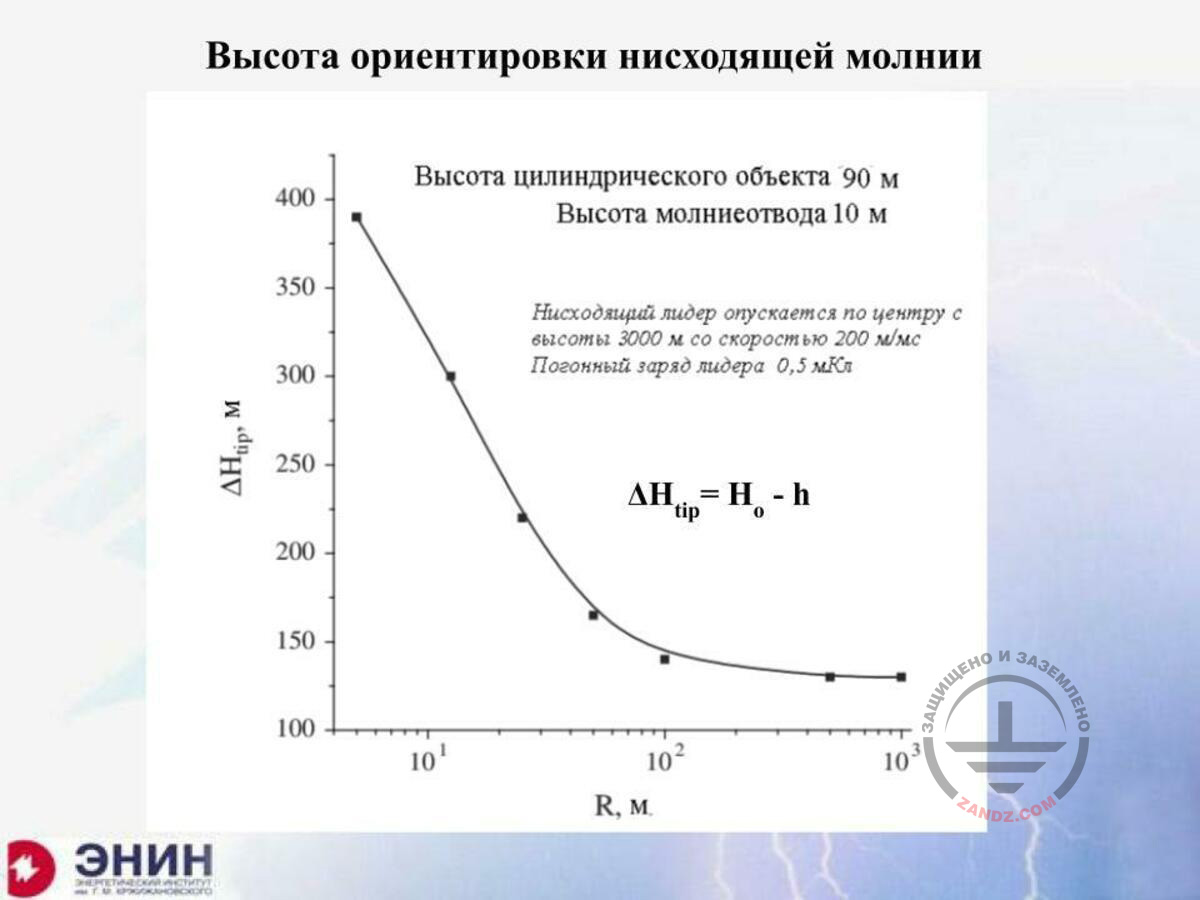
Height of downward lightning orientation
Высота ориентировки нисходящей молнии
Высота цилиндрического объекта 90 м
Высота молниеотвода 10 м
Нисходящий лидер опускается по центру с высоты 3000 м со скоростью 200 м/мс
Погонный заряд лидера 0,5 мКл
R, м
Height of downward lightning orientation
Height of the cylindrical facility 90 m
Height of the lightning arrester 10 m
Downward leader goes down in the center from the height of 3,000 m with the speed of 200 m/ms
Linear leader charge 0.5 mC
R, m
I have done the following thing: based on the computer modelling, I have plotted the curve of the height of orientation vs the cylindrical facility radius, above which the lightning arrester is installed. Here, the logarithmic scale along x-axis is used. For the facilities of 10 meters high, depending on the elevation radius, the orientation height begins dropping, and this means that the number of strikes into the facility also begins reducing. But I will repeat once again that I have made it for the model. This model is a mountain peak that is represented as a cylinder. It is difficult to make calculations for you right now considering the real configuration of this peak, so I did not want to do this.
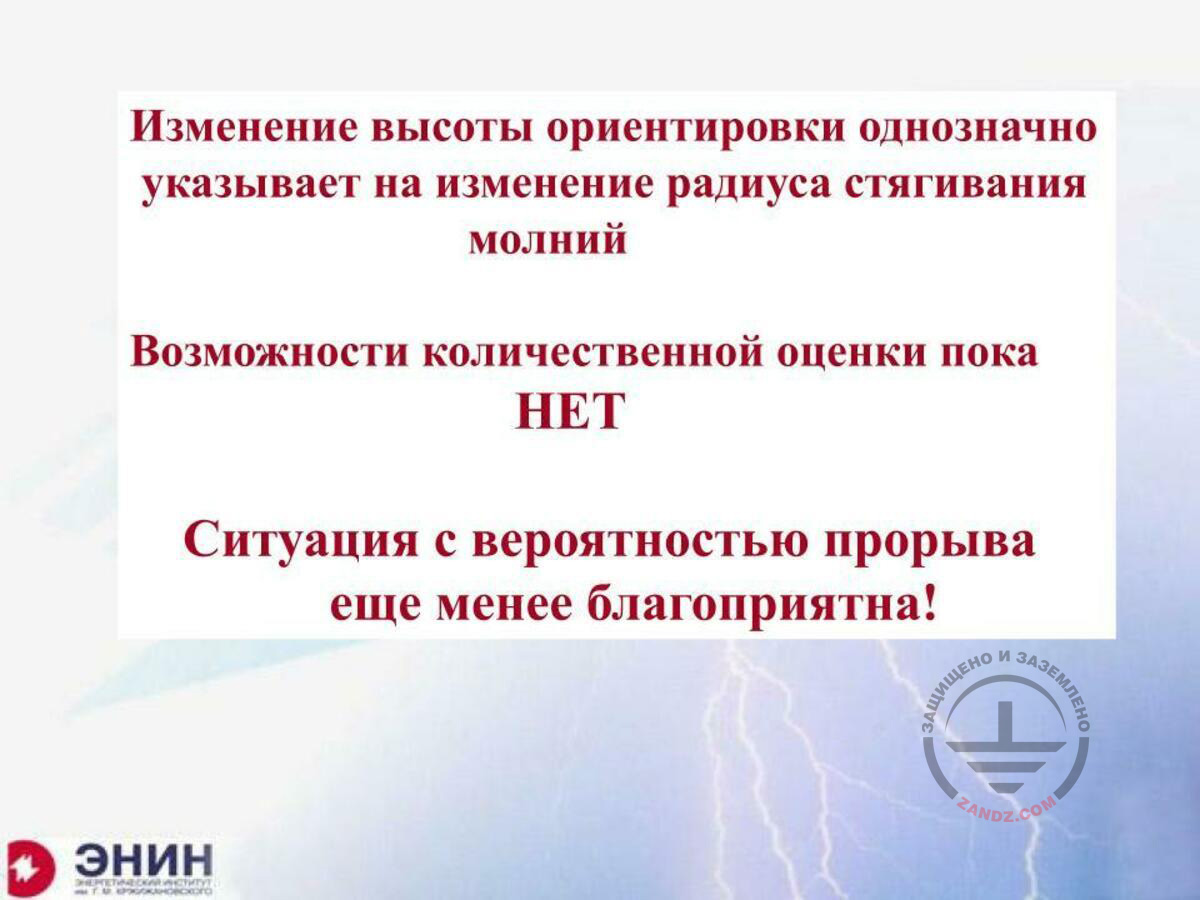
Change in the orientation height
Изменение высоты ориентировки однозначно указывает на изменение радиуса стягивания молний
Возможности количественной оценки пока НЕТ
Ситуация с вероятностью прорыва
еще менее благоприятна!
Change in the orientation height definitely indicates the change in the lightning collection radius
NOT possible to estimate quantitatively yet
The situation with the breakthrough probability is even less favorable!
I may summarize it as follows: if the facility is located in the gorge, then the probability of the lightning breakthrough is reduced, and typically in all cases, the facility may be operated without any lightning protection. And our Ministry of Energy adopted such solution for the power lines in the Soviet Union. Now, the second question: the facility is on the upland, and probably the number of strikes into the facility increases, but we need to make calculations for the particular facility located on the particular upland taking into account the profile of this upland. It may be done even today. I repeat that this computer task is rather complicated but it can be solved. For example, if our institute obtains such order, we will solve this task, but there is another one: the lightning rod and the protected facility are installed on this upland. And we have to solve one more task: how will the lightning arrester located on a mountain top protect this particular facility? We do not actually have any approach to solve such tasks. We cannot calculate the reliability of the facility protection on the top.
<< Previous page
slides from 1 to 7
Next page >>
slides from 15 to 22 + Questions and answers
Related Articles:
 Lightning Protection of Large Territories: Parks, Grounds, Plant Territories. Page 1
Lightning Protection of Large Territories: Parks, Grounds, Plant Territories. Page 1
 Lightning Protection of Large Territories: Parks, Grounds, Plant Territories. Page 2
Lightning Protection of Large Territories: Parks, Grounds, Plant Territories. Page 2
 Lightning Protection of Large Territories: Parks, Grounds, Plant Territories. Page 3
Lightning Protection of Large Territories: Parks, Grounds, Plant Territories. Page 3

